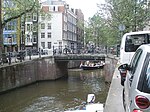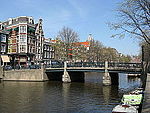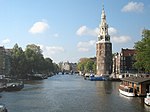Scheepvaarthuis

The Shipping House (Dutch: Scheepvaarthuis) is a building on the western tip of the Waalseiland near Amsterdam harbour that is one of the top 100 Dutch heritage sites and generally regarded as the first true example of the Amsterdam School, a style characterised by "expressive dynamism, lavish ornamentation and colourful embellishments". It is situated on the Prins Hendrikkade and was erected on the spot where Cornelis Houtman's first trip to the East Indies had begun in 1595. The first part was built 1913 - 1916 (during World War I); the second part was built 1926 -1928. Originally, it was the headquarters of six leading Amsterdam shipping companies: the Netherlands Steamship Company (SMN), the Royal Packet Navigation Company (KPM), the Java-China-Japan Line (JCJL) and the Royal Dutch Steamboat Company (KNSM) with subsidiary New Rhine Navigation Company (NRM) and acquired in 1912 Royal West India Mail Service (KWIM).
Excerpt from the Wikipedia article Scheepvaarthuis (License: CC BY-SA 3.0, Authors, Images).Scheepvaarthuis
Prins Hendrikkade, Amsterdam Centrum
Geographical coordinates (GPS) Address External links Nearby Places Show on map
Geographical coordinates (GPS)
| Latitude | Longitude |
|---|---|
| N 52.3744 ° | E 4.9041 ° |
Address
Scheepvaarthuis
Prins Hendrikkade
1011 AK Amsterdam, Centrum
North Holland, Netherlands
Open on Google Maps










